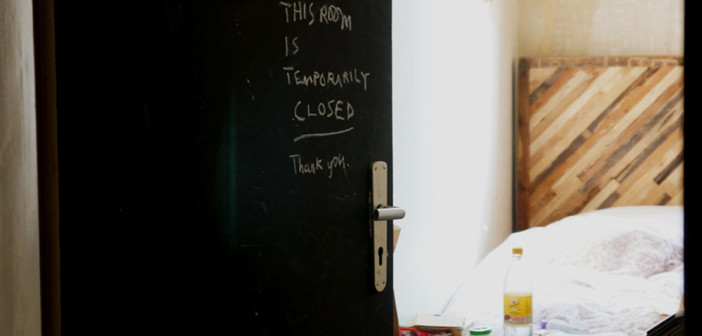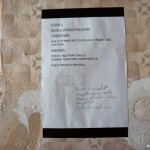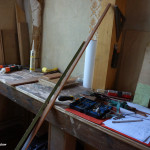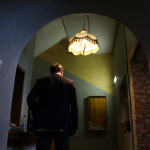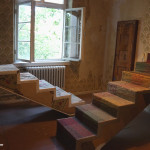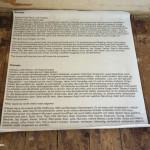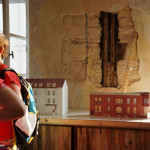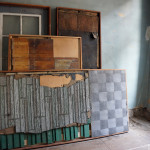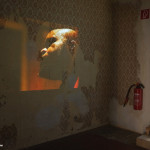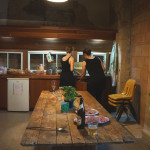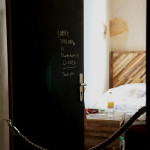dOCUMENTA, one of the largest and most important contemporary art exhibits in the world, takes place in Kassel, Germany every five years. In 2012, the 13th edition of dOCUMENTA presented work by more than 300 artists at eight major venues in Kassel as well as at sites in Kabul, Afghanistan; Alexandria and Cairo, Egypt; and Banff, Canada.
2012 curator Carolyn Christov-Bakargiev described the focus of dOCUMENTA (13) as "terrains where politics are inseparable from a sensual, energetic, and worldly alliance between current research in various scientific and artistic fields and other knowledges, both ancient and contemporary." In other words, approaches to problems that manage to be simultaneously politically engaged and earthy, regardless of whether they are arrived at via technology or folk wisdom.
American artist and cultural planner Theaster Gates’ work fits the bill perfectly. A native of the South Side of Chicago, Gates took over an abandoned hotel in Kassel for the 100 days of dOCUMENTA (13) and used materials sourced from abandoned buildings that he is rehabbing in his hometown to bring the dilapidated building back to life. Gates had a team of nine American and German artists and craftspeople living in the space around the clock, hosting screenings and performances for visitors while they went about the business of cooking their meals and refinishing the building.
I grabbed a little bit of Gates’ time to talk about his highly acclaimed installation, 12 ballads for Huguenot House at dOCUMENTA (13).
HK: Can you describe your project at dOCUMENTA? Talk about what you are aiming at as well the actual product if you don’t mind.
TG: I guess first of all I am making the case that, with my skill set as an artist, I am better prepared to think about the problem of abandoned spaces and the possibility of culture in abandoned spaces than other people. I’m claiming real problems in the world—like abandoned space in urban environments—as the best kinds of artistic problems to deal with. So I was trying to create a tangible indicator of the problem of abandoned space and at the same time, a kind of poetic solution to the problem.
In demonstrating space activation from the perspective of an artist, I am thinking about both the building and the programming of the building as my sculpture. In other words, the sculpture is not just the building, and not just the objects in the building, and not just the people who might pass through it, and not just the fact that we had to figure out everything that we wanted to do with the city. As an artist I see the whole problem of reactivating a building, creating a labor team… all of that…as one big problem.
I’ve also thought a lot about how I can leverage an abandoned building in Chicago—part of Huguenot House is about Chicago—because I’m bringing materials and labor from Chicago.
All images courtesy of Heather Kapplow.
HK: Wait, when you say you are bringing labor from Chicago, what do you mean by that?
TG: I mean literal labor! I have a guy from Dorchester Avenue—a young guy from my block—who became an apprentice in this process. He worked on the gutting of the building in Chicago [Dorchester Projects, a community cultural space developed in a previously abandoned building that Gates now owns on Chicago’s South Side.] He got trained on the guts about how to clean up things and design things while the materials were being processed here in Chicago and then the materials got shipped to Germany, and he went to Germany for two and a half months—this is Nick—and helped with the rehab of the Huguenot House. He made beautiful things happen inside of the building while he lived there.
The reality is, in the art world, someone has to build, and when you are doing projects this large, institutions are going to pay for it. So as an artist, I am thinking again: how can the real life problem of the need for jobs in a neighborhood like the South Side [of Chicago]or high unemployment in Germany be addressed?
HK: Who were the German workers involved in the creation of Huguenot House?
TG: There’s an organization galled the "Galama" group that works with unemployed workers to find them jobs for not-for-profit organizations. I was very fortunate to have this group become part of my team. They did all of the plastering and painting and cleaning and some of the carpentry work that helped to make the building work.
HK: How did they respond to the experience?
TG: As artisans! They loved it! There is a way in which, coming into the project, they imagined themselves mostly as laborers, you know, "You want that area plastered? We’ll plaster it." But then what happened somewhere in the middle is that we had to make decisions that were not about fully restoring a wall by plastering it the best way possible. It was more about marks that you make as a craftsman to preserve… to be able to see some of the history and all that. So there was a moment where they just became more conscious of the creative process while doing traditional craftwork.
HK: Jeez, how will they go back to just typical work assignments after this?
TG: A couple of the guys and one of the women, I think they just regard themselves as more creative people than they had when they started. And that’s awesome.
HK: What kind of experience are you hoping for an audience that passes through the space very briefly to have?
TG: What people experienced was—in addition to restoring the building a bit, nine people who were working on it were living in the building and they continued to live their ‘normal lives’ so people visiting were constantly thrown between private and public space. For the first few weeks, we also had the Black Monks of Mississippi who brought a really specific cultural overlay (a musical overlay—the black voice) into the space. So you know the first kind of occupancy was breathing, in advance of living, there was just song and sound.
HK: It sounds very ritualistic, very spiritual...
TG: Well, that’s part of my training. There’s a way that spaces have a capacity to be very special or stigmatized, sacred or desacrilized, and there’s a kind of theater—there is performance built into this body of work that is both literal performance, and performing what buildings should do. Modeling what good buildings do for a place.
HK: Ah, so each visitor got a small taste of both… Let’s go back to talking about the building itself. Why did you choose this site and what is the German-ness or Kassel-ness of the project? What was your criteria when you were searching for a site?
TG: I wanted a big problem. When an artist is invited to participate in Documenta, you are shown lots of spaces, and I think for the traditional painter or sculptor—those people may want a white box that their work can be seen inside of—as much decontextualization as possible.
For others, Kassel was the problem—the history of war, the history of genocide, Kassel’s role in the Nazi slaughter—some artists really took up that problem. And they picked it up in very specific places because there was content there related to it.
Two thirds of my building had been bombed, I knew that, and I could have made it a relic of—a kind of casualty of war—but I decided that there are a couple of things that you can do with this problem: You can mourn it, or criticize it, or historicize it, or celebrate what has survived and emerged afterwards. I decided that my response was going to be to celebrate all of what Kassel is and has been in some way.
When I was looking at sites with the curator, Carolyn, we initially thought that the Huguenot House, because it was abandoned, would be good starting place. Kind of like my project in St. Louis [Holiness in 3 Parts] we thought it could be a site that I could extract things from to make works of art that would land somewhere else.
But after some real thought, and as I considered my previous projects, I thought "how can I use Huguenot House, and the problems of its history—being bombed in WWII and never really being fully reactivated after that—to talk about how the outcome is the same even when the reasons for a building’s abandonment are very different?" I started thinking about how to match up what had happened to these two abandoned buildings—Huguenot House and Dorchester in Chicago.
HK: In what ways did you find them to correspond?
TG: Well, the goal was to say that all kinds of communities need unexpected spaces where cultural programming happens. Where culture is generative and iterative. If I begin my art practice with the problem of space, I arrive at an understanding that great things can happen almost anywhere. Some other conditions are necessary in order for great things to happen, and I was lucky that those things were in place in Kassel.
HK: What kinds of conditions? Were they in place because of dOCUMENTA? Or because of Kassel itself?
TG: I think in part the environment was activated because of dOCUMENTA. It was great that 45 artists—dancers and musicians—were working next door on Tino Sehgal’s piece. They were hungry for a gathering space where culture could happen, and so they became participants in my space. But we also had folk who were local who knew Huguenot House from their youth—they had had sex in it, they had smoked their first joint in it, they had practiced their saxophone in it—it was a place that held memory even in its abandonment, so people were extremely excited that something final and formal was starting to happen to it. That they could enter it on new terms.
They were thrilled that the building was…in a way being redeemed. Not only for me and for dOCUMENTA, but for them to experience in a legal and legitimate way. Once the space was activated and programmed, local, Kassel-based organizations were like "Hey, can we use this space to show movies and have a cultural center after dOCUMENTA?" and this is what you want.
All images courtesy of Heather Kapplow.
HK: That’s exactly what you want as an artist—to leave a permanent mark, but one that is organic enough that it loses its authorship eventually.
TG: And it’s gifted by this art experience called dOCUMENTA. It returns to the local, it feeds the local.
HK: How do you see yourself as representing America in this context?
TG: I don’t think I would frame my work or myself or my goals as having anything to do with my Americanness. The problem that I have is above nationhood. It’s the problem of why and how and cities fail to value and honor culture.
HK: But obviously, dOCUMENTA is an international platform where you are putting forward an agenda, so at the very least, you are making a statement about what you value that will be associated with your citizenship.
TG: Well, let’s put it this way: There’s a way in which the problem of American blight is not in the failure of the industrial city—or the industrial core in our cities. Blight is actually quite universal, so how do cities start to regain dignity and economy for their people and for its space when portions of the city have failed? I’m asking this question at a global level, but I guess I’m answering it as an American—a product of my environment.
HK: And you’re making the case that the best route there is through poetry?
TG: That it takes culture. This is part of what rebuilt Kassel. Kassel was rebuilt on a premise that culture is necessary for the growth of the community. In this case, for its rebirth post-1945. I’m restating this case—that culture continues. Not just art objects.
What I do best wherever I’m working is remind people of how wonderful and how powerful and important narrative is to the materials that we use. And the care for materials, buildings and people—how important those things are. In my practice I don’t begin by thinking "what beautiful art objects should I make?" I lead with a really specific question—a polemic of space. And as a result of that polemic—in this case two abandoned buildings that are both blighted and abandoned—I was asking how solving that problem can generate space. I create opportunities—for objects to be made, for performances to happen, for soapboxes to be stood upon.
HK: Is there any thing that you didn’t expect—that surprised you about the space?
TG: One of the things that became clear is that I can’t do a project like this by myself. Nor does a building that big want one owner, one use. In a way, if I didn’t have my team staying in the space, if the Black Monks didn’t come, if the camera crew wasn’t there, if Tino Segal’s dancers weren’t also performing in the space, it would have been less than what’s possible in that space. That the space—what it told me about itself was that it had great capacity to receive a lot of good things. If somebody was just willing to program, ask, coordinate—and those aren’t the words that you think of when you think of when you think of artistic genius—but it’s actually that stuff that makes projects special.
HK: I’m not going to ask you "what’s next" because that’s a bit of a lazy question. I can wait and find out for myself. Instead I’ll ask you a question that has been burning a very tiny hole in my mind since the first time I heard about you and your work. Then I’ll end this with an observation I’ve made about your career and ask you for your response.
What does your name mean? I’ve never met or heard of a Theaster before...
TG: It was my dad’s name. They say it circulated in the south for a long time and that when he was young there were several Theasters in the Delta region. The most that I’ve been able to find out about its history is that its origin is a Greek name that ended up somewhere along the line becoming the British name Thester. Theaster, the Southern version, is said to mean "Star of God." I’m the star of God!
HK: Wow. Ok, well finally, it seems to me as if things have moved very fast for you as an artist. As if the scale of your work has jumped annually. How do manage the pace?
TG: It doesn’t seem that way to me! But I do feel like I am just really getting to a comfortable position with things. Like my body and my brain are just starting to get really activated and excited. It’s about capacity. I’ve worked for departments of planning and for large cultural institutions managing and thinking about culture for whole neighborhoods or for the city or for parts of the city, so I think what’s happened is that a sense of institutional scale is also embedded in how I imagine my own projects coming into being. So instead of the department of cultural affairs having a 4 million dollar budget, I actually need that 4 million dollar budget myself to generate culture and I’m being quite sincere when I say I think there’s a way in which I function better at this scale of cultural production. I still need a studio practice—I am actively pursuing that—but I also want to do other things that are about being a creative citizen in the world, a good neighbor.
- One of many sets of instructions at Huguenot House. All images courtesy of Heather Kapplow.
- An active workbench at Huguenot House, All images courtesy of Heather Kapplow.
- A visitor entering Gates’ 12 Ballads for Huguenot House. All images courtesy of Heather Kapplow.
- Stoops taken from Chicago to Kassel to serve as informal meeting space at Huguenot House. All images courtesy of Heather Kapplow.
- Theaster Gates’ artist statement on floor in living room at Huguenot House. All images courtesy of Heather Kapplow.
- Models of Huguenot House and the Dorchester Projects building in Chicago in living room at Huguenot House. All images courtesy of Heather Kapplow. :
- Materials brought from Chicago for use at Huguenot House. All images courtesy of Heather Kapplow.
- Screening on wall at Huguenot House of an earlier performance that took place in the house. All images courtesy of Heather Kapplow.
- Residents of Huguenot House preparing dinner. All images courtesy of Heather Kapplow.
- A peek into one of several bedrooms in use at Huguenot House. All images courtesy of Heather Kapplow.

